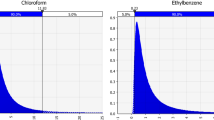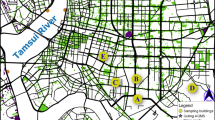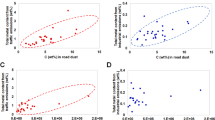Abstract
We estimated the level and determinants of airborne concentrations of 26 volatile organic compounds (VOC) in rural Western Canada. A multisite, multimonth unbalanced two-factorial design was used to collect air samples at 1206 fixed sites across a geographic area associated with primary oil and gas industry in Alberta, northeastern British Columbia, and central and southern Saskatchewan from April 2001 to December 2002. Principal component factor analysis was used to group VOC into three mixtures. Factor I was a group of compounds dominated by benzene, toluene, ethyl-benzene, xylenes, and hexane. Factor II was mainly a group of vegetation-related monoterpenes and dichlorobenzenes. Factor III was a group of chlorinated VOC. Linear mixed effects models were applied to identify the determinants of airborne concentrations of VOC and evaluate the association between these factors and oil and gas facilities. Our results indicated that the studied VOC were present in small (ng/m3) quantities. Components of Factor I VOC showed a seasonal variation with maxima in winter and minima in summer, whereas components of Factor II displayed an opposite seasonal trend. Components of Factor III did not show a clear seasonal pattern. We observed that oil and gas facilities only contribute to airborne concentrations of components of Factor I. Proximity to batteries (within 2 km) was most influential in determining monthly airborne concentrations of components of Factor I, followed by gas and oil wells. Modification of batteries to reduce evaporation and leakage might be considered as a measure to control airborne concentrations of compounds such as benzene and toluene.
This is a preview of subscription content, access via your institution
Access options
Subscribe to this journal
Receive 6 print issues and online access
$259.00 per year
only $43.17 per issue
Buy this article
- Purchase on Springer Link
- Instant access to full article PDF
Prices may be subject to local taxes which are calculated during checkout



Similar content being viewed by others
References
Alberta Environment. Approaches to a Total (or Grouped) VOC Guideline Final Report 2002 Available at: http://www3.gov.ab.ca/env/protenf/publications/approaches_VOC_guideline.pdf. Accessed June 7, 2005.
ATSDR. Chloroform: Potential for Human Exposure 1998 Available at: http://www.atsdr.cdc.gov/toxprofiles/tp6-c5.pdf. Accessed October 11, 2005.
ATSDR. Finalized Toxicological Profiles 2005 Available at: http://www.atsdr.cdc.gov/toxprofiles. Accessed July 2005.
Bertin N., Staudt M., Hansen U., Seufert G., Ciccioli P., and Foster P., et al. Diurnal and seasonal course of monoterpene emissions from Quercus ilex (L.) under natural conditions — applications of light and temperature algorithms. Atmosph Environ 1997: 31: 135–144.
Burnett R.T., Dales R.E., Raizenne M.E., Krewski D., Summers P.W., and Roberts G.R., et al. Effects of low ambient levels of ozone and sulfates on the frequency of respiratory admissions to Ontario hospitals. Environ Res 1994: 65 (2): 172–194.
Burstyn I. Principal component analysis is a powerful instrument in occupational hygiene inquiries. Ann Occup Hyg 2004: 48: 655–661.
Canadian Council of Ministers of the Environment (CCME). Canadian 1996 NOx/VOC Science Assessment. Ground-Level Ozone and Its Precursors 1980 to 1993 — Report of the Data Analysis Working Group 1997.
Canadian Association of Petroleum Producers. CH4 and VOC Emissions from the Canadian Upstream Oil and Gas Industry — Volume 1 1999 Available at: http://www.capp.ca/raw.asp?x=1&dt=ntv&e=pdf&dn=84180. Accessed August 8, 2005.
Chan C.Y., Chan L.Y., Wang X.M., Liu Y.M., Lee S.C., and Zou S.C., et al. Volatile organic compounds in roadside microenvironments of metropolitan Hong Kong. Atmos Environ 2002: 36 (12): 2039–2047.
Cheng L., Fu L., Angle R.P., and Sandhu H.S. Seasonal variations of volatile organic compounds in Edmonton, Alberta. Atmos Environ 1996: 31: 239–246.
Cohen M.A., Ryan P.B., Spengler J.D., and Ozkaynak H. Source-receptor study of volatile organic compounds and particulate matter in the Kanawha Valley, WV-I. Methods and descriptive statistics. Atmos Environ 1991: 25B: 79–93.
Cressie N.A.C. Statistics for Spatial Data. John Wiley and Sons Canada, Ltd.: Canada, Revised Edition 1993.
Derwent R.G., Middleton D.R., Field R.A., Goldstone M.E., Lester J.N., and Perry R. Analysis and interpretation of air quality data from an urban roadside location in central London over the period from July 1991 to July 1992. Atmos Environ 1995: 29: 923–946.
Derwent R.G. Sources, Distributions, and Fates of VOCs in the Atmosphere. In: Hester RE, Harrison RM, (eds). Issues in Environmental Science and Technology 4, Volatile Organic Compounds in the Atmosphere 1995 1st edn. Thomas Graham House, Science Park, Milton Road, Cambridge, CB$ 4WF, UK: The Royal Society of Chemistry 1995.
Environment Canada. 2000 Criteria Air Contaminant Emissions for Canada (tonnes) 2004 Available at: www.ec.gc.ca/pdb/ape/ape_tables/canada2000_e.cfm. Accessed October 12, 2005.
Environment Canada. 2005b. Total Biogenic VOC Emissions for 1995, Available at: www.ec.gc.ca/pdb/ape/ape_tables/bioVOC95_e.cf. Accessed October 12, 2005.
EPA. Carcinogenic Effects of Benzene: An Update 1998 Available at: http://www.epa.gov/ncea/pdfs/benzenef.pdf. Accessed November 7, 2005.
Gilli G., Scursation E., and Bono R. Benzene, toluene and xylenes in air, geographical distribution in the Piedmont region (Italy) and personal exposure. Sci Total Environ 1994: 148: 49–56.
Goldstein A.H., Wofsy S.C., and Spivakovsky C.M. Seasonal variations of nonmethane hydrocarbons in rural New England: constraints on OH concentrations in northern midlatitudes. J Geophys Res 1995: 100: 21023–21033.
Hagerman L.M., Aneja V.P., and Lonneman W.A. Characterization of non-methane hydrocarbons in the rural Southeast United States. Atmos Environ 1997: 31: 4017–4038.
Hass U., Lund S.P., Simonsen L., and Fries A.S. Effects of prenatal exposure to xylene on postnatal development and behavior in rats. Neurotoxicol Teratol 1995: 17 (3): 341–349.
Hewitt C.N., Cao X., Boissard C., and Duckhum S.C. Atmospheric VOCs from natural sources, 1995 In: Hester RE, Harrison RM, (Eds). Issues in Environmental Science and Technology, Vol 4, Volatile Organic Compounds in the Atmosphere, 1st edn. Thomas Graham House, Science Park, Milton Road, Cambridge CB4 4WF, UK: The Royal Society of Chemistry, pp 17–36.
Jobson B.T., Wu Z., and Niki H. Seasonal trends of isoprene, c2–c5 alkanes, and acetylene at a remote boreal site in Canada. J Geophys Res 1994: 99: 1589–1599.
Kolstad H.A., Juel K., Olsen J., and Lynge E. Exposure to styrene and chronic health effects: mortality and incidence of solid cancers in the Danish reinforced plastics industry. Occup Environ Med 1995: 52 (5): 320–327.
Meijster T., Burstyn I., Van Wendel de Joode B., Posthumus M., and Kromhout H. Evaluating exposures to complex mixtures of chemicals during a new production process in the plastics industry. Ann Occup Hyg 2004: 48: 499–507.
Millet D.B., Donahue N.M., Pandiis S.N., Polidori A., Stanier C.O., and Turpin B.J., et al. Atmospheric volatile organic compound measurements during the Pittsburgh Air Quality Study: results, interpretation, and quantification of primary and secondary contributions. J Geophys Res 2005: 110: D07S07.
Na K., and Kim Y. Seasonal Characteristics of ambient volatile organic compounds in Seoul, Korea. Atmos Environ 2001: 35 (15): 2603–2614.
Ono A., Sekita K., Ogawa Y., Hirose A., Suzuki S., and Saito M., et al. Reproductive and developmental toxicity studies of toluene. II. Effects of inhalation exposure on fertility in rats. J Environ Pathol, Toxicol Oncol 1996: 15 (1): 9–20.
Papadopoulos A., Vassilakos C., Hatzianestis J., Maggos T., and Bartzis J.G. Volatile organic compounds concentration levels on a day without traffic in the centre of Athens. Fresenius Environ Bull 2005: 14 (6): 498–502.
Parnia S., Brown J.L., and Frew A.J. The role of pollutants in allergic sensitization and the development of asthma. Allergy 2002: 57: 1111–1117.
Paulu C., Aschengrau A., and Ozonoff D. Tetrachloroethylene-contaminated drinking water in Massachusetts and the risk of colon-rectum, lung, and other cancers. Environ Health Perspect 1999: 107 (4): 265–271.
Pearson M.A., Hoyme H.E., Seaver L.H., and Rimsza M.E. Toluene embryopathy: delineation of the phenotype and comparison with fetal alcohol syndrome. Pediatrics 1994: 93 (2): 211–215.
Penkett S.A., Blake N.J., Lightman P., Marsh A.R.W., Anwyl P., and Butcher G. The seasonal variation of nonmethane hydrocarbons in the free troposphere over the North Atlantic Ocean: possible evidence for extensive reactions of hydrocarbons with the nitrate radical. J Geophys Res 1993: 48: 2865–2885.
Rappaport S.M. Assessment of long-term exposures to toxic substances in air. AnnOccup Hyg 1991: 35 (1): 61–121.
Schuh G., Heiden A.C., Hoffmann T., Kahl J., Rockel P., and Rudolph J., et al. Emissions of volatile organic compounds from sunflower and beech: dependence on temperature and light intensity. J Atmos Chem 1997: 27: 291–318.
Scott H.M., Soskolne C.L., Martin S.W., Ellehoj E.A., Coppock R.W., and Guidotti T.L., et al. Comparison of two atmospheric-dispersion models to assess farm-site exposure to sour-gas processing-plant emissions. Prev Vet Med 2003: 57: 15–34.
Solberg S., Schmidbauer N., Pedersen U., and Schaug J. VOC measurements August 1992–June 1993, EMEP/CCC, 1993.
The Australia National Environment Protection Council. National Environment Protection (Air Toxics) Measure Explanatory document 2004 Available at: http://www.ephc.gov.au/nepms/air/air_toxics.html. Accessed October 19, 2005.
United Kingdom Photochemical Oxidants Review Group. Ozone in the United Kingdom. Department of the Environment, Transport & Regions, London, 1993.
Uno I., Wakamatsu S., Wadden R.A., Konno S., and Koshio H. Evaluation of hydrocarbon reactivity in urban air. Atmos Environ 1985: 19: 1283–1293.
Upmanis H., Eliasson I., and Andersson-skold Y. Case studies of the spatial variation of Benzene and Toluene concentrations in parks and adjacent built-up areas. Water, Air, Soil Pollut 2001: 129: 61–81.
Strosher M.T. Investigation of flare gas emissions in Alberta. Final report to: Environmental Canada conservation and protection, the Alberta Energy and Utilities Board and the Canadian Association of Petroleum Producers, Alberta Research Council: Calgary, Alberta, Canada.
Acknowledgements
The study would not have been possible without funding from the Western Interprovincial Scientific Studies Association, RWDI Air Inc. that collected air samples, and AirZone One Inc. that conducted laboratory analyses. We also wish to thank Alberta Energy and Utilities Board, Oil and Gas Commission of British Columbia and Petroleum Development Branch of Government of Saskatchewan who provide regulatory data on location and type of oil and gas facilities. Elise Pietroniro and Cheryl Waldner at the University of Saskatchewan earned our gratitude for computing distances between air monitoring stations and oil and gas facilities, and creating the map of monitoring sites. Cheryl Waldner is also the principal investigator of the epidemiological (animal health) project for which air quality measurements were collected. Finally, we thank Jianduan Liang and Narmatha Thanigasalam at the University of Alberta who created SAS program that calculated distance weights.
Author information
Authors and Affiliations
Corresponding author
Rights and permissions
About this article
Cite this article
You, X., Senthilselvan, A., Cherry, N. et al. Determinants of airborne concentrations of volatile organic compounds in rural areas of Western Canada. J Expo Sci Environ Epidemiol 18, 117–128 (2008). https://doi.org/10.1038/sj.jes.7500556
Received:
Accepted:
Published:
Issue Date:
DOI: https://doi.org/10.1038/sj.jes.7500556
Keywords
This article is cited by
-
Photo-catalytic oxidation of individual and mixture of benzene, toluene and p-xylene
International Journal of Environmental Science and Technology (2016)
-
Influences of ambient air pollutants and meteorological conditions on ozone variations in Kaohsiung, Taiwan
Stochastic Environmental Research and Risk Assessment (2015)
-
Impact of measurement error on quantifying the importance of proximity to point sources of air pollution
Journal of Exposure Science & Environmental Epidemiology (2010)



